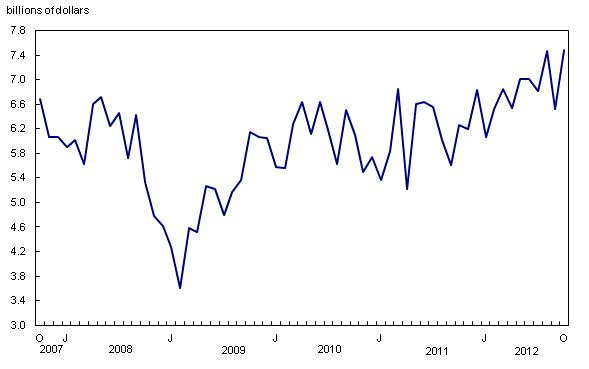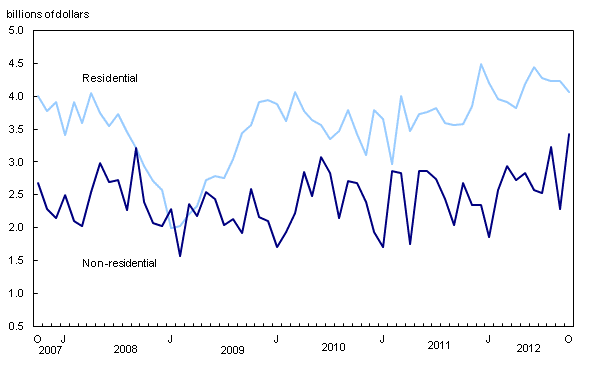Building permits, October 2012
Archived Content
Information identified as archived is provided for reference, research or recordkeeping purposes. It is not subject to the Government of Canada Web Standards and has not been altered or updated since it was archived. Please "contact us" to request a format other than those available.
Related subjects
-
[an error occurred while processing this directive]
The total value of building permits rose 15.0% to $7.5 billion in October, following a 12.7% decline in September. The increase was primarily the result of higher construction intentions for non-residential buildings, mostly in Ontario and Quebec.
Total value of permits

Chart description: Total value of permits
Construction intentions in the non-residential sector grew 50.3% to $3.4 billion, following a 29.4% decrease in September. Ontario and Quebec were responsible for most of the advance observed at the national level. British Columbia and Prince Edward Island posted declines.
In the residential sector, the value of permits fell 4.1% to $4.1 billion in October, the third monthly decrease in four months. British Columbia had the largest decline, followed by Ontario. Saskatchewan, Alberta and Manitoba also recorded decreases. The Atlantic provinces and Quebec posted gains.
Non-residential sector: Strong gains in the industrial and institutional components
In the industrial component, the value of permits tripled to $1.1 billion in October, rising above the $1 billion mark for the first time. The increase, which followed a 48.8% decline in September, was largely the result of higher construction intentions for manufacturing plants, transportation-related buildings and utilities buildings. Construction intentions for industrial buildings were up in every province except Manitoba and New Brunswick.
The value of permits in the institutional component rose 69.6% to $982 million in October. The increase was largely attributable to higher construction intentions for medical facilities and educational institutions in Ontario, and for government buildings and educational institutions in Manitoba.
In the commercial component, the value of permits edged up 0.1% to $1.4 billion. The advance came from a variety of buildings, including retail complexes, recreational facilities, and hotels and restaurants in Ontario and Quebec. Commercial construction intentions declined in four provinces, with British Columbia and Alberta posting the largest decreases.
Residential and non-residential sectors

Chart description: Residential and non-residential sectors
Residential sector: Lower construction intentions for single-family and multi-family dwellings
Construction intentions for single-family dwellings fell 4.9% to $2.4 billion in October. It was the third decrease in four months. The decline was mainly attributable to lower construction intentions in five provinces, led by Ontario, with Manitoba and Quebec well behind. In contrast, Newfoundland and Labrador and Alberta recorded the largest gains.
Municipalities issued $1.7 billion worth of building permits for multi-family dwellings in October, 3.0% less than in September. It was the fourth consecutive monthly decrease. There were declines in three provinces, led by British Columbia, followed by Alberta and Saskatchewan. The decrease in British Columbia was enough to offset the advances observed in other provinces.
Municipalities approved the construction of 18,744 new dwellings in October, up 6.9% from September.
The growth was because of a 16.3% increase in multi-family units to 11,818. In contrast, the number of permits issued for single-family dwellings fell 6.0% to 6,926 units.
Provinces: Ontario and Quebec post the largest advances
In October, the total value of building permits was up in six provinces. Ontario had the largest advance, followed by Quebec and Manitoba.
Ontario's gain was attributable to a strong increase in non-residential building construction intentions.
In Quebec, the gain was mostly the result of higher construction intentions for industrial and commercial buildings and, to a lesser extent, for multi-family dwellings. In Manitoba, construction permits for institutional buildings and multi-family dwellings were behind the increase.
British Columbia saw the largest decline, as a result of lower construction intentions for commercial and institutional buildings and multi-family dwellings.
Higher permits value in most census metropolitan areas
In October, the total value of permits was up in 20 of Canada's 34 census metropolitan areas.
The largest increases were in Hamilton, Toronto and Montréal. In Hamilton, the advance came mainly from permits for institutional buildings and, to a lesser extent, for multi-family dwellings and commercial buildings.
Toronto's increase was primarily the result of higher construction intentions for non-residential buildings. In Montréal, the gain was attributable in particular to higher construction intentions for industrial buildings and multi-family dwellings.
Vancouver had the largest decline, primarily because of lower construction intentions for commercial buildings, multi-family dwellings and institutional buildings. In Saskatoon, the decrease stemmed largely from lower construction intentions for institutional buildings, while in Gatineau, multi-family dwellings and commercial buildings were behind the decrease.
Note to readers
Unless otherwise stated, this release presents seasonally adjusted data, which facilitates comparisons by removing the effects of seasonal variations. For more information on seasonal adjustment, see Seasonal adjustment and identifying economic trends.
The Building Permits Survey covers 2,400 municipalities representing 95% of the population. It provides an early indication of building activity.
The communities representing the other 5% of the population are very small, and their levels of building activity have little impact on the total for the entire population.
The value of planned construction activities shown in this release excludes engineering projects (for example, waterworks, sewers or culverts) and land.
For the purpose of this release, the census metropolitan area of Ottawa–Gatineau (Ontario/Quebec) is divided into two areas: Gatineau part and Ottawa part.
Revision
Data for the current reference month are subject to revision based on late responses. Data have been revised for the previous month.
Available without charge in CANSIM: tables CANSIM table026-0001 to 026-0008 and CANSIM table026-0010.
Definitions, data sources and methods: survey number survey number2802.
The October 2012 issue of Building Permits (Catalogue number64-001-X, free) will soon be available.
The November building permits data will be released on January 10, 2013.
For more information, contact us (toll-free 1-800-263-1136; infostats@statcan.gc.ca).
To enquire about the concepts, methods or data quality of this release, contact Jason Aston (613-951-0746), Investment, Science and Technology Division.
- Date modified:
